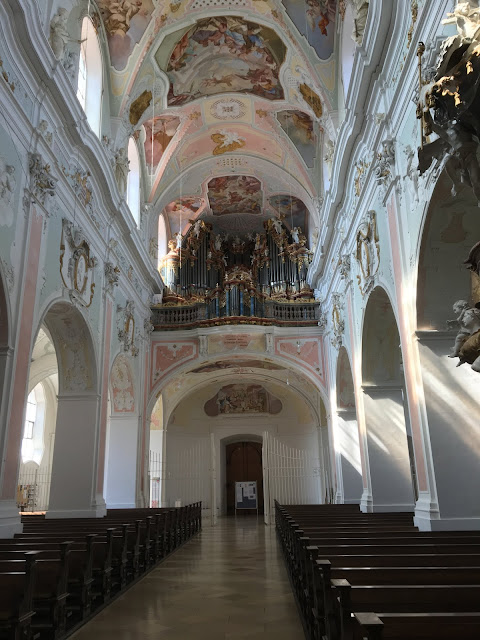 |
| We parked here too. By Wald-Burger8 - Own work, CC BY-SA 4.0, |
Ochsenhausen was an Imperial Abbey and at its zenith the abbot ruled over 255 square miles over 9000 subjects.
Stucco work is by Gaspare Mola. Frescoes below are by Johann Georg Bergmuller. There are scenes from the Bible and from the history of this Abbey.
This gives a better idea of the length of the building : from just in front of the central altar through into the long choir. The high altar in the distance is by D Zimmermann with a painting of the coronation of Mary by Schonfeld (1668) for which you would need a telescope...
Choir stalls just visible, date from 1686.
 |
| Add caption |
The pulpit by Agid Verehelt (1730-1) is an early example of the fantastic late Baroque style (cf Verzenheiligen, or Wies) and has a tasselled canopy and group of statuary as at the death of St Benedict.
Ochsenhausen is well known for its huge organ. It looks splendid and from recordings it sounds splendid. It was silent when I was there and I have not reached the age where I have the cheek to announce myself as "Godwin of St Barts, St Albans" and demand to play it! It is by Joseph Gabler (1725-30) and its multicoloured case is unforgettable.
A Monument of Faith. Introduced and played by Diane Bish.28 minutes of it but. after a short intoduction she does the famous JS Bach Toccata in d minor. Interesting too to see that she plays looking down the church. What an experience this must be.
Again we missed out on the Museum, the Library and the historic observatory from the 18th century. This contained the unique azimuth quadrant, a device to measure the position of the celestial bodies.
 |
| Part of the huge remaining huge abbey complex. |










No comments:
Post a Comment